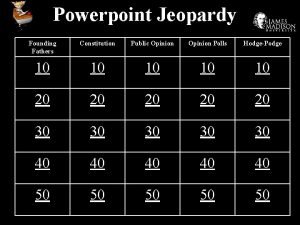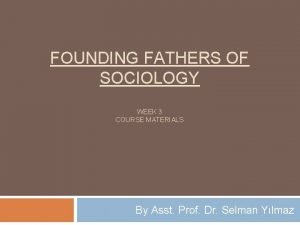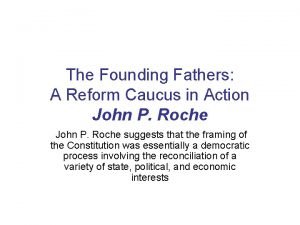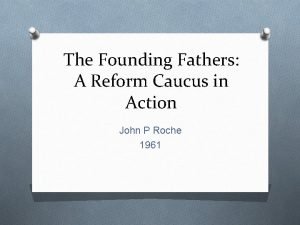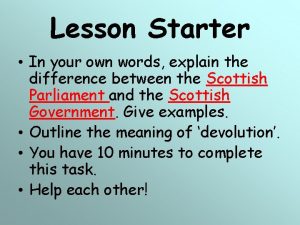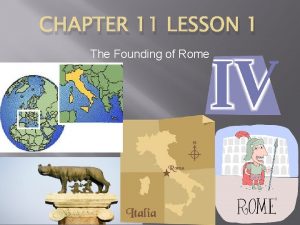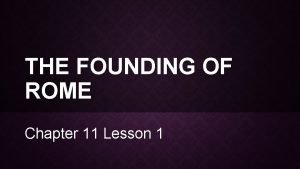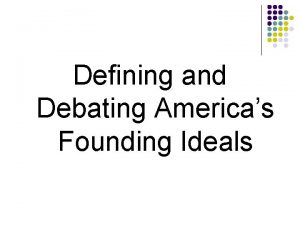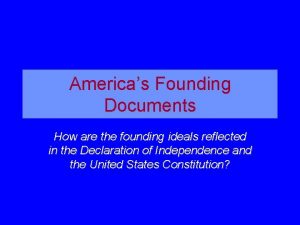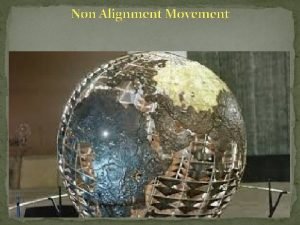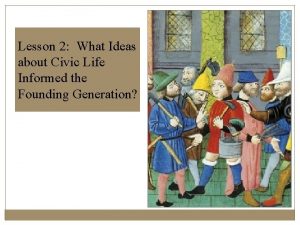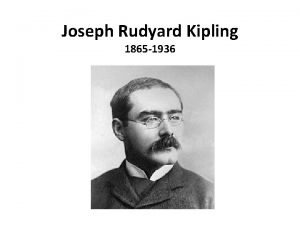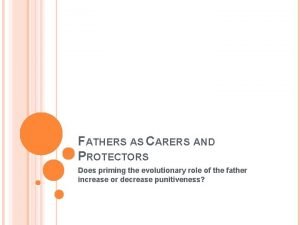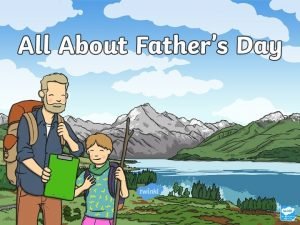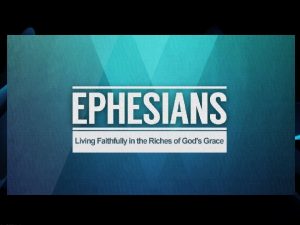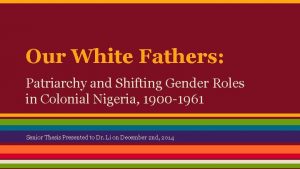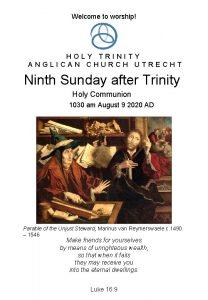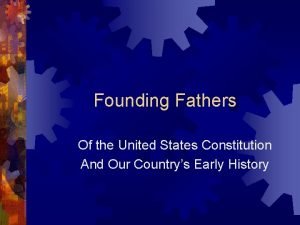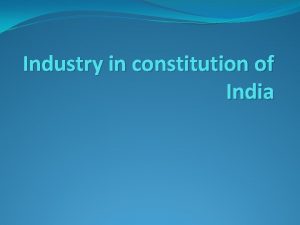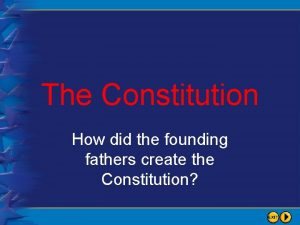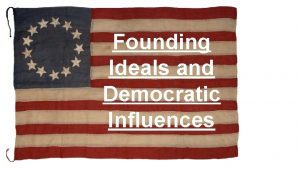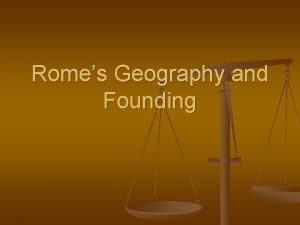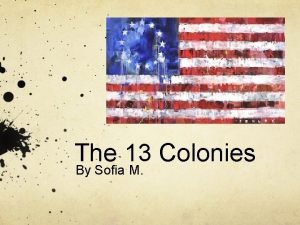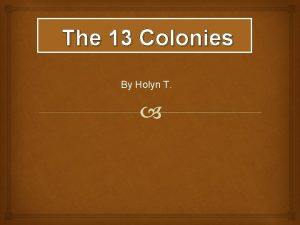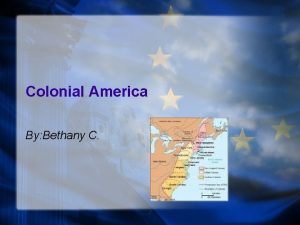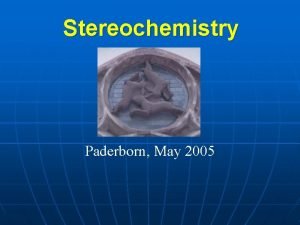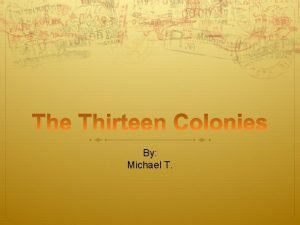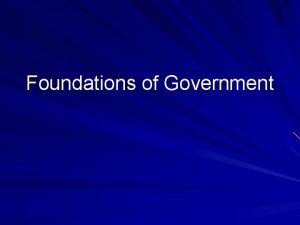The Constitution From the Founding Fathers to Today





































- Slides: 37

The Constitution From the Founding Fathers to Today

Features of the Constitutional System • Democratic government is based on the consent of the governed – Right to vote is the essence of consent • The labyrinth system of our constitutional system—checks and balances, separation of powers, etc. —provides citizens with both opportunities and hurdles to advance their causes

Foundations of Democracy • Colonists were happy until the British government started looking for financial support • First settlement—Jamestown, VA (1607) – Commercial enterprise of the Virginia Company of London • By 1619, the colonists have created the House of Burgesses – First legislative body

Foundations of Democracy • In 1624, the Crown realized there was no gold and took control of the colony – Instill a royal governor • Religious dissenters, in 1625, create Plymouth, MA – Reject the Catholic pope and the king of England – Yet the Puritans were also intolerant of dissent • Flock to Rhode Island with Roger Williams

Economic Distress • Colonies were suppliers of raw materials • These are shipped to British factories and then sold back to the colonies – Colonies were only permitted to trade with the Crown • Leads to smuggling and piracy • Colonial governor do not care because of their salary • Seven Years’ War (French and Indian War) – UK defends colonies from the French and Native Americans – To help defray costs, the UK taxes sugar and stamps

Economic Distress • Parliament delivers the Townshend Acts – Taxes on lots of goods (glass, paper, tea, lead) • Colonists decide to boycott British goods – 1773—Boston Tea Party—East Indian Company • Parliament responds by blockading the harbor and quartering troops • Tensions are high…First Continental Congress meets in 1774 in Philadelphia – Want to restore good relations, but declare a list of grievances and urge a boycott of British goods – All we ask for is a say • In early 1775, Second Continental Congress meets – Marshal military forces under Washington – Plan to finance war effort thru loans and bonds – Also produced the Articles of Confederation • Revolution opens on April 19, 1775 in Lexington

Declaration of Independence • List of grievances against King George III • “Life, liberty, and the pursuit of happiness” – Borrowed from John Locke – These rights are granted by God • Citizens have right to abolish a government when it is not protecting their rights • 27 specific issues • Only applied to males of sufficient means • Only 1/3 of Americans supported independence • Thomas Paine—Common Sense

Birth of a Nation • Articles of Confederation – Single Congress…every state has one vote • Nine votes to pass…Unanimous to change – Colonies were sovereign [independent] – Three huge problems: • No national currency • No control of interstate commerce • No federal taxes – Hard to be an economic power • Hamilton Course Reader! – Farmers were hard hit by the high price for imported goods • In 1786, Shays Rebellion occurs

Road to Philadelphia • In 1786, representatives meet for the Annapolis Convention – Five states – Discuss weaknesses of the articles – Schedule a meeting for May 1787 to “revise the Articles of Confederation” • • All states but Rhode Island show up Thoughts were not unified Meet in secrecy “Group of extremely talented democratic politicians seeking practical answers to practical problems confronting them”

New Constitution • Edmund Randolph presents the Virginia Plan – Bicameral legislature – Lower House popularly chosen – Upper House selected by Lower House – Why did small states not like this? • William Patterson presents the New Jersey Plan – Equal state representation – More powers over trade and security – Plural executive body…chosen by Congress

New Constitution • Roger Sherman presents the Great Compromise – Lower House allocated by population – Upper House equal votes – Money bills initiate in lower House

Regional Tensions • How do we count for slaves? – Taxation v. representation for the South • Tax imports, but no tax exports • • • Three-fifths Compromise How do we handle runaway slaves? What do we do about trade? When can slavery end? Constitution would take effect once 9 states ratified it – Ingenious aspect was the incorporation of a process for change

Constitutional Construction • 4, 068 words—Fairly short • Preamble and seven articles • Preamble: – “We the People…” • Article I – Establish bicameral legislature – Everything about Congress – Article I, Section 8: Elastic/Necessary and Proper

Constitutional Construction • Article II: – Establishes the executive branch • Article III: – Establishes judicial branch – Creates Supreme Court and gives Congress power to create more • Article IV: – Relations among states – Recognize legitimacy of each other’s laws

Constitutional Construction • Article V: – Provisions for amendment • Article VI: – Federal government assumes responsibility for national debt – Supremacy Clause • Article VII: – Discusses ratification

Fight for Ratification • Federalists: support the new Constitution – Bill of Rights not necessary because document limits powers enough (Webster Course. Reader!) • Antifederalists: Opponents – – – Drawn from all over Many farmers Small town members Didn’t like that Framers overstepped their bounds Points of disagreement: • • Strong central government forgets states Senators serve too long Lack of Bill of Rights Presidency is new

Battle in the States • Constitution finds support in: – – Commercial centers Western territories [want protection] Plantation owners Smaller states • Delaware first state to ratify • Federalist Papers – John Jay, Alexander Hamilton, James Madison • • 85 articles Extol virtues of new Constitution Federalist 10 warns of factions…threaten unity New nation counters factions

Making Good on a Promise • Federalists get states to budge by promising a Bill of Rights • First three amendments hit on political liberties • Next five outline basic rights • Last two deal with federal-state relations • States did not have to incorporate until the 14 th amendment in 1868

Amendments • • • 1: Freedom of speech, religion, press, assembly, and petition 2: Right to bear arms 3: No quartering 4: Search and seizure 5: Double jeopardy, self-incrimination, use of grand juries 6: Speedy trial, jury of peers, right to be informed of charges, right to counsel 7: Right to jury trial 8: Cruel and unusual punishment/excessive bail 9: Mandates that rights not explicitly listed belong to the people 10: Mandates that powers not given to national government are reserved to the states and people

Constitutional Change • Two methods • First: – Amendment introduced by Congress – Approved by 2/3 of each House – States ratify • Second: – 2/3 of state legislatures call for a national convention – NEVER USED

Constitutional Change • Must be ratified by ¾ of states – Can either happen by approval of state legislatures or by ratifying conventions • Originally amendments had no fixed time limit – Amendment 27 was proposed by Madison and passed 203 years later • Not meant to change easily • Since 1789, we’ve had 10, 000 amendments proposed – We have 27

Constitutional Principles • Make government strong enough to meet the nation’s needs • Do not threaten the existence of the separate states • Do not threaten liberty • Base it on popular consent • We grant and deny powers – Habeas corpus, ex post facto laws

Separation of Powers/Checks and Balances • Locke gives us the idea of separation of powers • Montesquieu gives us checks and balances • No branch can consolidate too much power • Overlap so cooperation is required • Prevent arbitrary use of power • Examples? ? ?

Federalism • Some powers are controlled by different levels of government – Declare war? – Ability to create towns? – Power to tax?

Institutional Adaptation • • Adapt to the times Survive power struggles Declaration of war is a prime example Changes in state-federal relationship

Judicial Review • Marbury v. Madison (1804) – Makes Supreme Court able to rule on constitutionality of a law…judicial review

More Voters • Originally white, propertied, adult males could vote • 1800 s see property requirements disappear • 13 th amendment • 15 th amendment • 19 th amendment • 26 th amendment

Constitution and Civic Engagement • September 17 th…Constitution Day • Rights are never completely secure – We take inconveniences in stride…examples? • “Price of freedom is eternal vigilance”

Theory Underlying the Constitution • Two of the Federalist papers (No. 10 and 51) focus on the fundamental problem of selfgovernance. • We are not “angels” as Madison write, so how do we get a government of non-angels not only to govern the governed, but to “govern” itself as well?

Federalist No. 10 • Here Madison tackles the problem by both exploring the likelihood that tyranny of the majority would arise in a democracy and identifying a solution to such tyranny.

Federalist No. 10 • Responds to the strongest argument of the Antifederalists—that a “large Republic” cannot long survive. • Discusses the negatives of factions, which are defined as “a number of citizens, whether amounting to a majority or minority of the whole, who are united and actuated by some common impulse of passion, or of interest, adverse to the rights of other citizens, or to the permanent and aggregate interests of the community. ” • “Liberty is to faction what air is to fire…”

Federalist No. 10 • Madison then identifies two ways to eliminate factions, authoritarianism or conformism—neither of which is acceptable. • So if the causes of factions cannot be removed, then one must control their effects rather than “snuffing out liberty. ”

Federalist No. 10 • Minority and majority factions are controlled in different ways. • Democracy does not allow minorities to dominate. The problem lies with majorities. Direct democracy would allow for majority usurpation of minority rights. • However, a representative government would: – dilute factious spirit – negate the ability of potential majorities to attempt any form of collusion

Federalist No. 51 • A more mechanistic approach is taken in Federalist No. 51. • By separating government officers into different branches (separation of powers) and giving them the authority to interfere with each other’s actions (checks and balances) they could defend the integrity of their offices: – bicameralism – popular election – presidential veto • Ambition is made to counteract ambition. . . • This argument gave reassurances to those fence sitters who worried about a tyrannical government forming.

Federalist No. 10 and 51 • In summary, Federalist No. 10 conveys theory of pluralism that guided the Constitution’s chief architect. • Federalist No. 51 explores how and why the governmental system that emerged from the political process in Philadelphia might actually work. • But did they overdo it? What criticisms can be leveled at the system?

The Constitution: Born of Sweet Reason or Politics? • Irony: national pluralism Madison was striving to install already at work at the federal convention, frustrating their success. • Many of the Constitution’s provisions have no theoretical rationale; they are simply the hammered out products of compromise. – Can you think of examples? • Did Madison achieve this goal of building a national society that would prevent majority factions from tyrannizing local minorities? – What do you think? – What does the evidence suggest?

Questions for Thursday • What are the six institutions that large scale democracy is alleged to require? • What was wrong with the Articles of Confederation? How did the Constitution go about fixing the issues? • Why does Webster believe The Bill of Rights is absurd? Do you think it was necessary?
 Founding fathers powerpoint
Founding fathers powerpoint Founding fathers of sociology
Founding fathers of sociology The founding fathers a reform caucus in action
The founding fathers a reform caucus in action The founding fathers a reform caucus in action
The founding fathers a reform caucus in action The constitution lesson 1 principles of the constitution
The constitution lesson 1 principles of the constitution Texas constitution vs us constitution
Texas constitution vs us constitution Nc constitution vs us constitution
Nc constitution vs us constitution Constitution what is constitution
Constitution what is constitution Today meeting or today's meeting
Today meeting or today's meeting Today lesson or today's lesson
Today lesson or today's lesson For todays meeting
For todays meeting Today's lesson or today lesson
Today's lesson or today lesson Are we having class today
Are we having class today Example of repitition
Example of repitition Founding principles of the scottish parliament
Founding principles of the scottish parliament Chapter 11 lesson 1 the founding of rome
Chapter 11 lesson 1 the founding of rome Guided reading lesson 1 the founding of rome
Guided reading lesson 1 the founding of rome Discovering american ideals in primary sources
Discovering american ideals in primary sources America's founding ideals
America's founding ideals Nam founding members
Nam founding members English bill of rights
English bill of rights Plmar vision and mission
Plmar vision and mission Since our founding
Since our founding What philosophical ideas informed the founding generation?
What philosophical ideas informed the founding generation? The fathers love letter
The fathers love letter Father's day in italy
Father's day in italy Fathers chair
Fathers chair Tracing family descent through mothers rather than fathers
Tracing family descent through mothers rather than fathers Four score and seven years ago
Four score and seven years ago Father's day in turkey
Father's day in turkey Father's love is unconditional
Father's love is unconditional Fathers are protectors
Fathers are protectors History of fathers day
History of fathers day Harlon block
Harlon block Fathers do not provoke
Fathers do not provoke Who is the father of behaviorism
Who is the father of behaviorism White fathers in nigeria
White fathers in nigeria Church fathers trinity
Church fathers trinity
